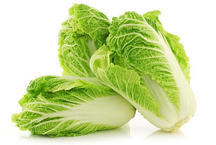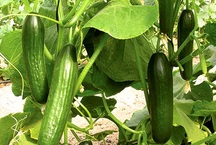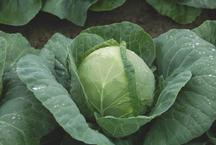Top 10 cauliflower varieties



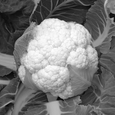

Cauliflower is well suited for growing in the middle zone, and this healthy vegetable has a lot of fans. How to choose a good cauliflower seeds, and will be discussed in our review.
The choice of variety depends on the region of cultivation.. In the northern part of Russia with a short summer it is better to plant hybrids of early ripening. For the Middle band suitable for both early and mid-season varieties and hybrids. Cultivation and late cauliflower through seedlings with a sufficient race is allowed.
Cauliflower likes moderate temperatures and high humidity. Sowing seeds for seedlings carried out in late March, you can sow later immediately in the greenhouse or greenhouse. The most common problem when setting up a head of cabbage is the lack of boron and cobalt. Therefore, during the formation of inflorescences (the end of the seedling period and a week after planting in the ground), these micronutrients need additional feeding. If you are late with top dressing before the head appears, then this can provoke premature flowering.
To extend the season of consumption, cauliflower seeds are sown at different times with an interval of 1 to 2 weeks or use additional summer planting in the ground.
Rating the best varieties of cauliflower
| Category | A place | Name | Rating | Price |
|---|---|---|---|---|
| The best early cauliflower varieties | 1 | Movir 2009 (Russia, 2012) | 9.8 / 10 | 25 |
| 2 | Koza-Dereza (Russia, 2007) | 9.8 / 10 | 30 | |
| 3 | Winson F1 (Holland, 2006) | 9.8 / 10 | 37 | |
| 4 | Fremont F1 (Holland, 2001) | 9.7 / 10 | 45 | |
| 5 | White F1 excellence (Russia, not listed) | 9.7 / 10 | 65 | |
| The best varieties and hybrids of cauliflower average maturity | 1 | Candide Sharm F1 (Japan, 2008) | 9.8 / 10 | 35 |
| 2 | Parisian (Russia, 2006) | 9.7 / 10 | 20 | |
| 3 | Klarifay F1 (Netherlands, 2008) | 9.7 / 10 | 38 | |
| The best late varieties and cauliflower hybrids | 1 | Skywalker F1 (Holland, 2003) | 9.8 / 10 | 80 |
| 2 | Incline F1 (Japan, 2008) | 9.8 / 10 | 59 |
The best early cauliflower varieties
|
Movir 2009 (Russia, 2012)
25 (in a package of 0.5 g)
The early cauliflower variety is an improved version of the old Soviet variety Movir 74. Forms a vertical rosette of leaves with a medium waxy coating, the waviness is weak. The plant is medium in size. The head is rounded-flattened, with a weak tuberosity, white or cream, partially covered with leaves, weighing 500 - 900 g. Allowed for cultivation throughout Russia, including Western Siberia and the Urals. Disease resistance is average. Easily adapts to growing conditions and knits heads even in adverse weather. It is distinguished by drought tolerance, while it grows well on waterlogged soils. Main advantages:
Minuses:
|
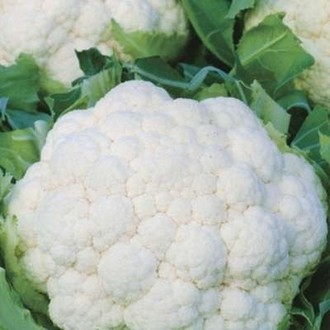 9.8 / 10
Rating
Reviews
Proven and stable in the middle lane. The inflorescences are very tasty, good and in conservation. |
|
Koza-Dereza (Russia, 2007)
30 (0.3 g per bag)
Early or middle-early variety of cauliflower for garden cultivation throughout Russia in open and protected ground. It has an upright compact rosette of leaves with a medium wax coating. The head is round, dense, moderately nodular, partly covered with leaves, average weight 800 g, with juicy and tender flesh. To get snow-white forks, you need additional shelter from the sun. Good reviews of this cauliflower variety are obtained from the summer residents of the Central and North-Western regions. When complying with agrotechnics disease is not affected. Does not require special attention when conducting dressings and filling the beds.
Main advantages:
Minuses:
|
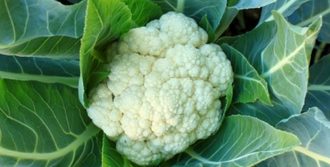 9.8 / 10
Rating
Reviews
Growing cauliflower is not the first season - never failed. Even in a bad year, it gives out small, but tight kochanchiki. |
|
Winson F1 (Holland, 2006)
37 (packing 10 seeds)
The early hybrid of cauliflower for country cultivation and small farmer production, zoned in all regions of Russia. Forms a vertical, slightly raised rosette of leaves. The head is rounded, flattened, of medium tuberosity, dense, half-hidden by leaves, weighing 1500 - 1800 g (sometimes up to 3 kg), snow-white, with very tender and tasty pulp. Gardeners note the increased resistance of the hybrid to high temperatures and violation of the irrigation regime. The harvest tolerates freezing and long-term storage in a cooled state.
Main advantages:
Minuses:
|
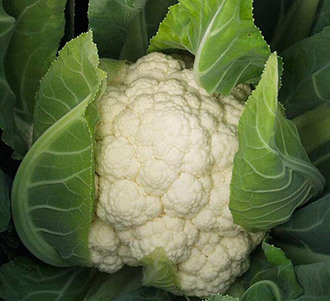 9.8 / 10
Rating
Reviews
Forms a dense head even in the absence of regular watering, it looks very resistant against the background of other varieties. It is also resistant to coloring. |
|
Fremont F1 (Holland, 2001)
45 (10 seeds)
Sredneranny hybrid for summer residents and farmers. Forms a raised, powerful rosette of leaves, painted in a dark green color. The head is flat-rounded or dome-shaped, dense, with rough tuberosity, completely covered with leaves, with an average weight of 1000 - 1500 g. In the registry in all regions of Russia. Cauliflower Fremont F1 is notable for its high stress resistance, good health and an active build-up of leaflets.
Main advantages:
Minuses:
|
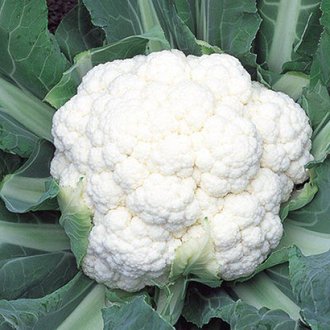 9.7 / 10
Rating
Reviews
This hybrid can not be tasted on your own plot: it is painfully praised on farmer forums. I did not disappoint. The quality of the crop is very good. |
|
White F1 excellence (Russia, not listed)
65 (30 pieces in a package)
Early hybrid cauliflower for greenhouses, film shelters and open ground. A short growing season allows to produce commercial products twice per season. The head is round, dense, snow-white, without yellowness, slightly hilly, well covered with large, wide leaves, weighing 900 to 1000 on average. It is distinguished by uniformity and high marketability. Positive experience of growing this cauliflower hybrid is shared by the gardeners of Moscow, Novgorod regions and Krasnoyarsk Krai. Main advantages:
Minuses:
|
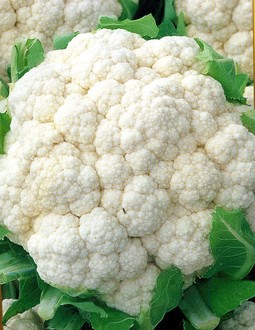 9.7 / 10
Rating
Reviews
In favorable years, the heads were 2.5–3 kg each, and no less than 1 kg. Knits without problems - I'm always with the harvest. |
The best varieties and hybrids of cauliflower average maturity
|
Candide Sharm F1 (Japan, 2008)
35 (15 seeds)
Adapted to the climate of the regions of Russia, a hybrid of cauliflower of average maturity. The leaves are medium in size, with wavy edges, raised. The head is flat, of a beautiful shape, medium-mild, very tight, partially covered with leaves. The average weight of product forks is 1200–2000. It is characterized by strong immunity and viability, patiently tolerates errors in agricultural technology.
Main advantages:
Minuses:
|
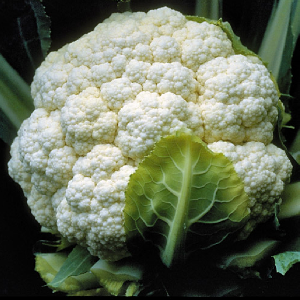 9.8 / 10
Rating
Reviews
Ties heads a little later than early hybrids. Plants are powerful and resistant to bad weather, well grow leaves. |
|
Parisian (Russia, 2006)
20 (0.5 g per bag)
Good mid-season domestic variety of cauliflower, approved for cultivation in all regions of Russia. The leaves grow vertically, the edges are slightly wavy. The head is dome-shaped, dense, leaves partially closed, weighs 750 g on average; tuberosity is moderately pronounced. It is well stored in the freeze, without changing the texture and taste. The summer-autumn period of cultivation is preferred. Differs in resistance to change of temperature and adverse weather factors.
Main advantages:
Minuses:
|
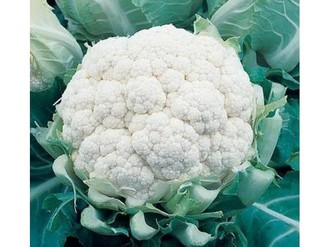 9.7 / 10
Rating
Reviews
Heads are pure white. If not covered further from the sun, they turn yellow slightly. The flesh is very tender and tasty. I tie up to 1.5 - 2 kg with good care. |
|
Klarifay F1 (Netherlands, 2008)
38 (10 seeds)
We continue our ranking of the best varieties of cauliflower hybrid average maturity for greenhouse and field cultivation in personal subsidiary farms. Forms a vertical rosette of elongated wavy leaves. The head is dome-shaped, moderately bumpy, partially covered with leaves, with white and tender flesh, small in size, weighing 600 - 1100 g. Distinguished by the genetic resistance to cruciferous keel. Knits heads even in adverse weather conditions.
Main advantages:
Minuses:
|
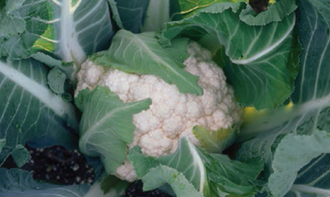 9.7 / 10
Rating
Reviews
Hybrid completely satisfied, planted for conveyor production of fresh cauliflower. The head gives out not large, but dense and weighty. |
The best late varieties and cauliflower hybrids
|
Skywalker F1 (Holland, 2003)
80 (10 seeds)
Late-ripe hybrid of cauliflower for greenhouses and open ground, can be grown in all regions with the condition to ensure the maturation of the heads. It has a vertical outlet of loosely wavy narrow leaves, a waxy coating is weak. The head is rounded-flat, dense, medium-carbon, covered with leaves, weighing 1500 - 3000 g. It is used for fresh consumption and freezing. Cauliflower Skywalker tolerates heat during the period of heading, resistant to disease.
Main advantages:
Minuses:
|
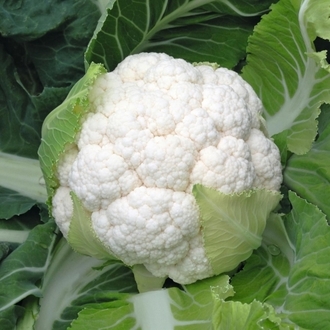 9.8 / 10
Rating
Reviews
Very productive and resistant hybrid, is responsive to top dressings. Cauliflower ripens in unison, preserves taste and density of inflorescences in freezing. |
|
Incline F1 (Japan, 2008)
59 (15 seeds)
Hybrid cauliflower late ripening, zoned in all regions of Russia. Designed for autumn use. It has a raised rosette of leaves. The leaves are large, wavy, with an average wax coating. The head is covered with leaves, oval-elongated, dense, moderately hilly; average weight is 600 g; individual heads in favorable years reach 1200–1500. The summer farmers of Leningrad, Moscow, Tver and Yaroslavl regions share positive cultivation experience.
Main advantages:
Minuses:
|
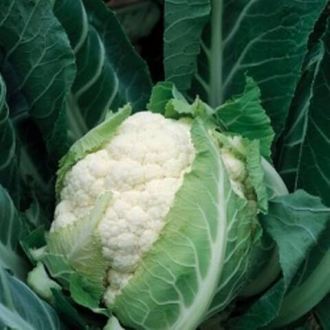 9.8 / 10
Rating
Reviews
Seedlings powerful, strong. Heads knit every season well, so we have this basic hybrid. |
How to grow a good crop of cauliflower?
Many summer residents after several unsuccessful attempts to get a quality crop refuse to grow cauliflower. The main reasons for disappointment are the invasions of the caterpillars and the poor setting of the head.
In the cultivation of cauliflower, the decisive role is played not so much by a good hybrid or variety, as by the correct preparation of the beds, compliance with the terms and conditions for growing seedlings, regular watering, and prevention of pest infestation and the development of diseases. Experienced gardeners eagerly share their secrets for growing cauliflower:
- it is better to acquire reliable varieties that have proven themselves in a particular region;
- seedlings are grown at a temperature of 5 - 10 degrees;
- for planting the bed is filled with dolomite flour and boric acid: 5 kg + 40 g with a consumption of 100 g / m2;
- it is necessary to introduce humus and ash during the growing season with superphosphate;
- solar sites are chosen for planting, but when the head is formed so that it does not turn yellow, the outer leaves are tied up in a bunch or covered with a covering material;
- To protect against pests, use light and thin lutrasil on arcs, under which cauliflower can grow from the moment of planting.
On hot days, plantings need shading from the scorching sun, but the beds for light-loving vegetables should not be done in partial shade.
Have a good harvest!
